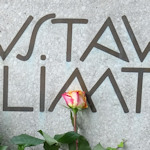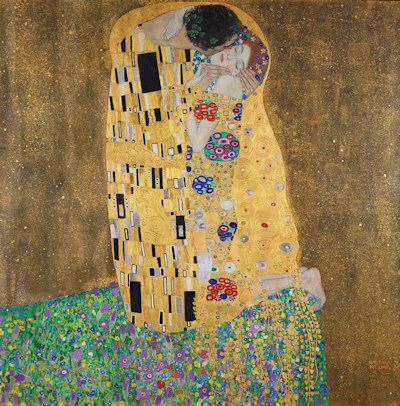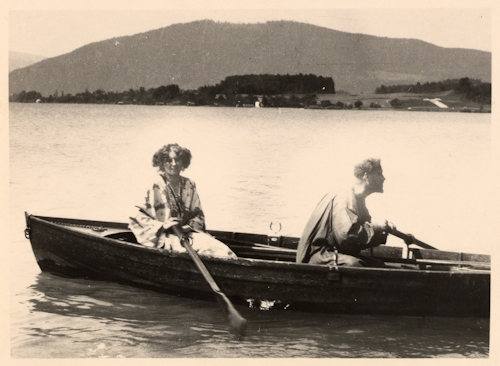
The official colours of Vienna are red and white. The unofficial ones are the black and gold colours of Gustav Klimt’s The Kiss: a truly iconic painting and probably the city’s greatest art treasure.
- Klimt’s famous work, created 1907-1908
- Painting’s past is surprisingly uneventful
- On display at Upper Belvedere
- Open daily and hugely popular
- Book your Upper Belvedere tickets*
- Tip: advance booking a time slot avoids a possible wait
- See also:
Jump to:
- How to see it (location and viewing tips)
Quick Upper Belvedere tickets
(Booking service provided by Tiqets.com*, who I am an affiliate of)
The painting
Klimt’s The Kiss seems to be everywhere in Vienna. For example, it’s nudged Emperor Franz Joseph and Empress Elisabeth to one side in the souvenir shops. And anything Klimt-related usually has the painting front and centre.

(The Kiss; photo courtesy of and © Belvedere, Wien. Reproduced with permission under the terms of Creative Commons License CC BY-SA 4.0.)
This presence has a perfectly good reason, though. Experts consider the 1907/1908 work to be the most iconic example of Austria’s local Jugendstil (Art Nouveau) period. But its fame and status has long gone global: The Kiss has caught the imagination of the world.
The painting first appeared in public at a 1908 exhibition organised around Klimt and colleagues; the “Kunstschau” featured many of the stalwarts of the Wiener Moderne movement.
Among the works on display and for sale that day: a composition by Klimt named the Lovers (the original title for The Kiss).

(Unknown photographer, Gustav Klimt and Emilie Flöge in a boat on the Attersee lake in 1909, not long after completion of the Kiss, Wien Museum Inv.-Nr. 157540; reproduced with permission under the terms of the CC0 licence)
Such a painting deserves a mysterious and troubled history of purchases, with the occasional theft thrown in for good measure. I fear the reality is far more banal.
The Ministry of Education bought the picture (the ministry’s remit at the time also included culture) for the state’s Moderne Galerie collection at Lower Belvedere palace in Vienna.
And that was more or less it, because it’s still at Belvedere (albeit at the Upper Palace now).
Klimt already has a couple of works in the list of the World’s Top 20 most expensive paintings. In 2023, for example, his Lady with a Fan sold for over €99 million (a record at the time for art sold at a European auction).
With at least one less-well-known Klimt work insured for US$300 million, you can only begin to imagine how much The Kiss is worth.
(Gustav Klimt’s painter’s smock from around 1905; Wien Museum Inv.-Nr. M 8641, Photo: Birgit und Peter Kainz, Wien Museum; reproduced under the terms of the CC BY 4.0 license)
I once asked a Belvedere gallery guide what it would sell for, and she just laughed hysterically. She also suggested a sale was rather unlikely unless Austria’s national debt takes a remarkable turn for the worse.
Nevertheless, you can actually “own” part of the painting by buying one ten thousandth of the official digitised image from Belvedere as an NFT. Last time I checked, pieces were still available.
Or you could just buy a postcard.
How can I see the Kiss?
The painting hangs on display in Vienna’s Belvedere complex.
The institution has several locations but, as mentioned earlier, you want Upper Belvedere palace; The Kiss makes up part of the permanent exhibition there.

(The rather fine home of The Kiss with a Christmas market outside)
You likely won’t be the only ones trying to see the masterpiece.
This is pretty much the most famous artwork in the entire country and one of the most famous in the world. So prepare to do battle by smartphone if you pick the wrong time to view it.
However, the crowd is nothing like those you get for the Mona Lisa at the Louvre. And The Kiss is quite large – about 1.8m by 1.8m – so easily admired from a little distance, if necessary.
Tickets and visitor tips
Here my recommendations for visiting Upper Belvedere and Klimt’s prestigious work:
Such is the interest in the paintings at Belvedere that the museum introduced time slots to manage the visitor numbers. So…
- Buy a ticket in advance*: then you can book a date and time slot that’s best for you. (I’d pick an early time so you have fewer visitors competing for space)
There’s a small risk if you buy at the door that your allocated slot may involve a wait, especially in busy parts of the year.
However, if you do prefer to simply buy on site and want a more gentle viewing experience, consider these three tips…
- Avoid weekends and holiday periods
- Go early. I’ve often gone to Belvedere just after it opens and enjoyed quiet, even around The Kiss and even at relatively popular times of year
- Pick the right season: slower periods for tourism are:
- Mid-January through to a couple of weeks before Easter
- A week or two after Easter through to early/mid June
- September, October and early November before the advent markets open
I say “slower” rather than “slow” because Vienna has become a popular destination across the whole year.
Finally, if you happen to be at Belvedere on February 14th, then you might find a special offer for couples.
While you’re there

(Gustav Klimt’s unfinished portrait of Amalie Zuckerkandl from 1918. One of many of his works in the Belvedere collection; press photo: Johannes Stoll / Belvedere, Vienna)
Don’t leave Upper Belvedere, of course, without taking a look around the permanent Vienna 1900 exhibition and other exhibition areas.
Expect a whole number of other works by Klimt. These include the almost-but-not-quite-as-famous-as-the-Kiss Judith, though that particular painting sometimes goes out on loan for exhibitions elsewhere.
The permanent collection also features art by the likes of, for example, Schiele, Rodin, Kokoschka, Munch, Makart, and similar.
Keep an eye out, as well, for any of Messerschmidt’s astonishing character heads that might be on display.
On top of that, you may find some special exhibitions at Belvedere (perhaps including a Klimt-themed one), and all with a serious dose of gorgeous Baroque architecture thrown in for good measure!
If you’re still up for more Klimt paintings or tracing his biography after your Belvedere visit, then I have various tips for other Viennese locations.
Definitely consider the Leopold Museum, for example, which has a significant number of works on display in their excellent permanent exhibition.
